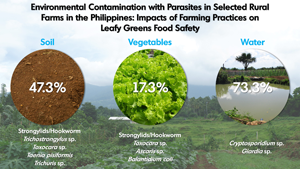Article contents
Environmental contamination with parasites in selected rural farms in the Philippines: impacts of farming practices on leafy greens food safety
Published online by Cambridge University Press: 06 December 2021
Abstract

Fresh vegetables are an important part of a healthy diet, however, they can also be agents of transmission of intestinal parasites. This study aimed to evaluate the presence of parasite contamination in vegetable farms as a source of transmission in selected rural communities in Laguna, Philippines. A total of 168 vegetable, 55 soil and 15 water samples collected from four selected farms and a reference farm were processed through various standard parasitological techniques. Of these, 17.3% of vegetables, 47.3% soil and 73.3% water samples were found contaminated with parasites’ eggs or cysts. Interestingly, leafy vegetables, such as lettuce, were found to be more contaminated. Results showed that strongylids/hookworms (egg/larva) showed the highest prevalence in farm soil (38.2%) and vegetable (13.1%); other helminth parasite eggs were also recovered such as Toxocara sp., Ascaris sp., Trichiuris, Trichostrongylus sp. and protozoan cysts of Balantidium coli. Cryptosporidium sp. oocysts of and Giardia sp. cysts were observed in all water samples in the farms. Furthermore, results revealed that some farming practices such as the use of improperly treated animals manure as fertilizers, unhygienic practice of farmers and sanitation issues were factors that contribute to parasite contamination in the farms. These findings have implications on food safety in poor-resource communities posing public health risks. Recommendations were discussed in the study for the control and prevention of parasite contamination at the farm level.
- Type
- Research Article
- Information
- Copyright
- Copyright © The Author(s), 2021. Published by Cambridge University Press
References
- 5
- Cited by





